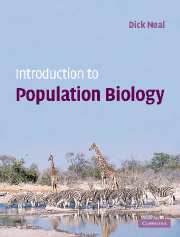Book contents
- Frontmatter
- Contents
- Preface
- Acknowledgements
- PART I Evolution by natural selection
- PART II Simple population growth models and their simulation
- PART III Population genetics and evolution
- Chapter 6 Gene frequencies and the Hardy–Weinberg principle
- Chapter 7 Mutation and the genetic variation of populations
- Chapter 8 Small populations, genetic drift and inbreeding
- Chapter 9 Migration, gene flow and the differentiation of populations
- Chapter 10 Quantifying natural selection: haploid and zygotic selection models
- Chapter 11 Applying zygotic selection models to natural systems
- Chapter 12 Polygenic inheritance, quantitative genetics and heritability
- Chapter 13 Population genetics: summary and synthesis
- PART IV Demography
- PART V Interactions between species, and the behaviour of individuals
- Glossary
- Solutions to problems
- References
- Index
Chapter 9 - Migration, gene flow and the differentiation of populations
- Frontmatter
- Contents
- Preface
- Acknowledgements
- PART I Evolution by natural selection
- PART II Simple population growth models and their simulation
- PART III Population genetics and evolution
- Chapter 6 Gene frequencies and the Hardy–Weinberg principle
- Chapter 7 Mutation and the genetic variation of populations
- Chapter 8 Small populations, genetic drift and inbreeding
- Chapter 9 Migration, gene flow and the differentiation of populations
- Chapter 10 Quantifying natural selection: haploid and zygotic selection models
- Chapter 11 Applying zygotic selection models to natural systems
- Chapter 12 Polygenic inheritance, quantitative genetics and heritability
- Chapter 13 Population genetics: summary and synthesis
- PART IV Demography
- PART V Interactions between species, and the behaviour of individuals
- Glossary
- Solutions to problems
- References
- Index
Summary
Ecologists and population geneticists view migration in very different ways. To the ecologist, migration is the movement of individuals or sometimes whole populations from one area to another. The movements often occur on an annual or seasonal basis, like the birds that overwinter in tropical and subtropical areas and then migrate north to breed in Holarctic regions during the spring or summer, or the caribou (Rangifer tarandus) herds that overwinter in the northern boreal forest and migrate north to calve on the tundra during the summer months. The movements may also be part of the life cycle, like in the Pacific sockeye salmon (Oncorhynchus nerka) that hatch in the headstreams of the rivers, move to the lower reaches of the rivers to feed, and then between the ages of three and seven years move to feed in the oceans before migrating back to their place of birth where they spawn and die. Ecologists seek to understand why animals migrate. Are they moving to take advantage of food resources that become available at different times and places, or is there some other explanation? Many of these migrations are spectacular and may cover huge distances, but to the population geneticist the issue is not how far they may have moved but whether there has been a movement of genes from one population to another. In other words, they are concerned about gene flow.
- Type
- Chapter
- Information
- Introduction to Population Biology , pp. 135 - 145Publisher: Cambridge University PressPrint publication year: 2003



